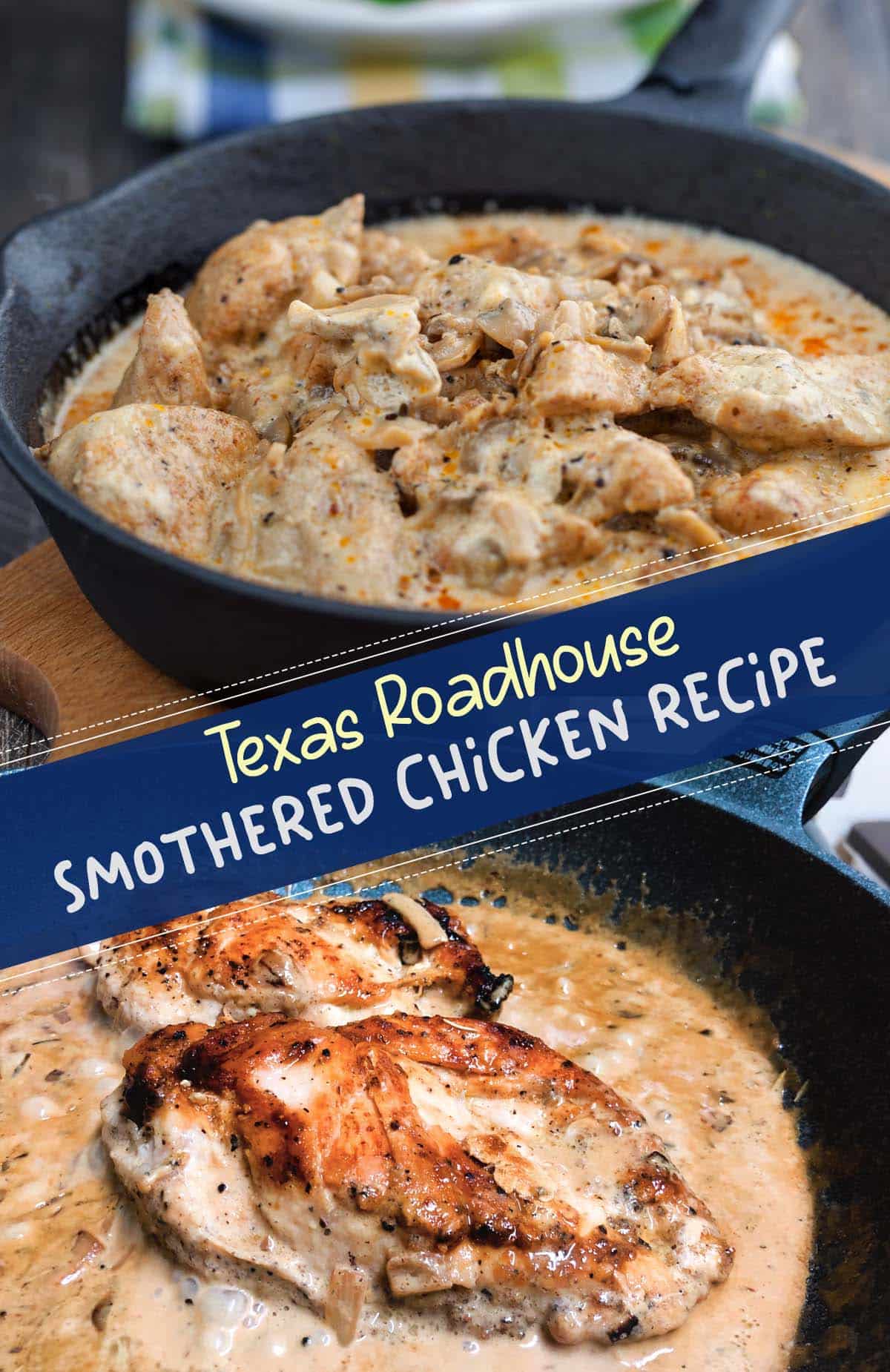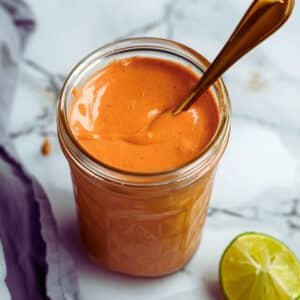I love the Smothered Chicken Texas Roadhouse because it combines tender, juicy chicken with a rich, creamy sauce that bursts with flavor. The mix of sautéed vegetables adds a delightful texture and freshness, while the melted cheese creates a luxurious mouthfeel. Every bite is a comforting and indulgent experience, making it the perfect dish to enjoy when I crave something hearty and satisfying.
Take Aways
- Searing the chicken: Searing the chicken breasts before smothering them in the sauce helps to develop a golden brown crust and lock in the natural juices.
- Balancing flavors: Make sure to taste and adjust seasonings as needed, considering the saltiness of the soups, cheese, and bacon.
- Cooking the vegetables: Sautéing them separately before adding them to the sauce helps maintain their texture and individual flavors.

What does smothered mean in cooking?
In cooking, "smothered" refers to a technique where food is gently simmered in a flavorful sauce, often with a lid or cover to trap the steam and moisture. This method allows the ingredients to cook slowly, infusing them with the rich flavors of the sauce while maintaining a tender and succulent texture.
Commonly used in Southern cuisine, smothering creates deeply satisfying dishes like Smothered Chicken, where the meat absorbs the aromatic spices and flavors from the surrounding gravy during cooking.
This smothering technique ensures a satisfying and succulent meal. Enjoyed at family gatherings, celebrations, and casual dinners, Smothered chicken holds a special place in the heart of Southern culinary traditions, delivering warmth and contentment with every bite.
Ingredients you'll need
Toppings:
- 7 strips bacon (cut into ¼ inch slices)
- Cheese (cheddar, muenster or pepper jack)
- Freshly chopped parsley (optional)
Chicken and dredge:
- ½ cup all-purpose flour
- 1 teaspoon of your desired seasonings
- 1 lb boneless skinless chicken breasts
- ½ cup vegetable oil
Vegetables:
- 8 oz fresh sliced mushrooms
- 1 green bell pepper, chopped
- ½ cup chopped onion
- 1 teaspoon minced garlic
For the sauce:
- 10.5 oz cream of mushroom soup
- 10.5 oz cream of chicken soup
- 8 oz button mushrooms, sliced
- 1 oz onion soup mix
- ½ cup chicken stock
- 1 tablespoon salt
Step-by-step Directions:
Refer to the recipe card below for a complete, printable version of the instructions.
Step 1
Begin by dicing the bacon strips and sautéing them in a skillet until they reach a crispy texture. Once cooked, set the bacon aside and carefully discard the excess grease.
Step 2
Sauté the mushrooms, green pepper, onion, and garlic in a harmonious blend of butter and oil, ensuring they reach a delightful crisp-tender state without overcooking them. Set aside.
Step 3
Combine flour and Italian seasoning in a shallow bowl, blending the ingredients to create a harmonious mixture for your dish. Set aside.
Step 4
Carefully butterfly the chicken breasts, creating even fillets, and then coat them thoroughly in the seasoned flour mixture, ensuring that every crevice of the chicken is well covered.
Step 5
Heat oil in the skillet, then carefully sear the chicken on both sides until it reaches a beautiful golden brown hue. Then, transfer it to a plate and drain any excess oil from the skillet.
Step 6
Start by melting the butter in the skillet, and then introduce the onions, sautéing them until they reach a soft, translucent state that unlocks their inherent sweetness and savory notes.
Step 7
Proceed by adding the garlic and sautéing until its enticing aroma fills the air. Gradually introduce the sauce ingredients, allowing them to meld together. Gently bring the sauce to a boil before reducing the heat to achieve a gentle simmer, which will help the flavors to develop and harmonize.
Step 8
After reaching the right consistency, nestle the chicken into the sumptuous gravy, ensuring it's well-coated and ready to absorb all the rich flavors. Let it simmers and gradually thicken, creating a luscious, velvety texture.
Step 9
Put the cooked vegetables into the dish, letting their different tastes mix and make a yummy combination of flavors, making your meal even better and more enjoyable.
Step 10
Sprinkle the chicken with the crisped bacon, adding a delightful contrast of textures. Partially cover the skillet with a lid, allowing the sauce to continue simmering and thickening while the chicken cooks to perfection.
Step 11
Place shredded or large slices of cheese onto the dish. (I personally enjoy using pepper jack cheese.) Cover with a lid briefly, allowing the cheese to melt through the vegetables and over the chicken.
Note:
To ensure the chicken is fully cooked, use an instant-read meat thermometer to confirm an internal temperature of 165°F. Finally, embellish your culinary masterpiece with a sprinkle of fresh parsley, and present your enticing dish, ready to be savored and enjoyed.
Read:
Why use these key ingredients
The importance of key ingredients in elevating your cooking
- Boneless chicken breasts: This lean, protein-rich meat serves as the star of the dish, providing a tender and moist base that absorbs the flavors of the sauce and seasonings. Choosing boneless cuts ensures even cooking and easy eating.
- Salt, pepper, and desired seasonings: These essential spices enhance the natural flavors of the chicken and vegetables, creating a well-balanced and tasty dish. Personalized seasonings allow for customization and the opportunity to explore various flavor profiles.
- Cooking oil and butter: A combination of oil and butter provides the perfect medium for searing the chicken and sautéing the vegetables. The butter adds a rich, creamy note, while the oil prevents the butter from burning.
- Fresh sliced mushrooms: These earthy, flavorful vegetables add depth and complexity to the dish, complementing the chicken and other ingredients while contributing a delightful texture.
- Chopped green pepper: The green pepper brings a mild, slightly sweet taste and a bit of crunch, balancing the sauce's richness and adding vibrant color.
- Chopped onion and minced garlic: These aromatic ingredients form the foundation of the dish's flavor profile, contributing savory, sweet, and pungent notes that elevate the overall taste.
- Cheese: Adding your favorite cheese, such as cheddar, muenster, or pepper jack, introduces a creamy, rich, and slightly tangy element that melds perfectly with the other ingredients, creating a more indulgent and satisfying meal.
- Cream of mushroom and cream of chicken soup: These canned soups act as the base for the sauce, delivering a rich, velvety texture and concentrated flavors that envelop the chicken and vegetables.
- Button mushrooms and sliced onions: Including additional mushrooms and onions in the sauce intensifies the flavors, ensuring that every bite is packed with the essence of these key ingredients.
- Onion soup mix: This convenient mix imparts a burst of savory, umami flavor to the sauce, bringing out the best in the chicken and vegetables.
- Chicken stock: Adding chicken stock to the sauce provides moisture and reinforces the dish's overall flavor with a depth of taste that complements the other ingredients.
- Seasoning salt: A final touch of seasoning salt brings out the dish's natural flavors, tying together all the ingredients in a harmonious and delicious culinary creation.
Smothered chicken as a comfort food
For generations, smothered chicken has been comforting people with its hearty and savory flavors. The low and slow cooking process allows the chicken to absorb all the rich flavors of the sauce, resulting in tender, juicy meat that bursts with flavor.
One of the reasons why people find smothered chicken comforting is because it is steeped in tradition and nostalgia. It reminds many of us of our childhoods and family gatherings, giving us a sense of warmth and security.
Read:
Mastering the art of smothered chicken.
To make the perfect Smothered Chicken, follow these tips and tricks:
- Choose the right cut: Use boneless, skinless chicken breasts or thighs for even cooking and easy eating. Thighs tend to be juicier and more flavorful, while breasts are leaner.
- Pound the chicken: If using chicken breasts, pound them to an even thickness to ensure uniform cooking and a more tender result.
- Properly season: Season the chicken with salt, pepper, and other desired spices before dredging in flour to enhance the flavor.
- Sear the chicken: Sear the chicken over medium-high heat to achieve a beautiful golden-brown crust, adding flavor and texture to the dish.
- Use fresh ingredients: Use fresh vegetables like onions, mushrooms, and bell peppers for better flavor and texture.
- Layer flavors: Sauté the onions and garlic in the same pan as the chicken to build a flavorful base for the sauce.
- Adjust the sauce consistency: If the sauce is too thick, add more chicken stock to thin it out. If it's too thin, allow it to simmer uncovered for a few minutes to thicken, or add a slurry of cornstarch and water.
- Don't overcook the chicken: Use an instant-read meat thermometer to ensure the chicken is cooked to an internal temperature of 165°F. Overcooking can result in dry, tough meat.
- Let the sauce simmer: Allow the sauce to simmer gently for a few minutes before adding the chicken back in, which helps the flavors meld together, and the sauce thickens.
- Garnish: Use fresh herbs like parsley, chives, or cilantro for added flavor, color, and visual appeal.
- Rest the dish: Let the dish rest for a few minutes before serving to allow the flavors to meld and the sauce to thicken further.
- Taste and adjust: Before serving, taste the sauce and adjust the seasoning if needed. The result is a flavorful and well-balanced meal.
Stewed vs. Smothered Chicken:
Two delicious cooking techniques that result in tender and flavorful dishes are Stewed Chicken and Smothered Chicken, which are distinct.
Stewed chicken involves slowly cooking chicken pieces in a liquid base, like water, broth, wine, vegetables, and spices. This method produces a lighter, more subtle flavor with a lower calorie and fat content, making it suitable for soups, stews, and pot pies.
On the other hand, Smothered Chicken is prepared by simmering chicken in a rich, thick sauce made from a roux and sautéed vegetables, resulting in a deeply savory and indulgent dish that pairs well with rice, mashed potatoes, or vegetables. While both dishes offer versatility in ingredients and adaptations, Smothered Chicken boasts a more intense flavor profile and higher fat content due to its sauce-based preparation.
Despite their differences, both Stewed and Smothered chicken provide satisfying, comforting meals that home cooks and diners alike can enjoy.
| Definition | Stewed Chicken | Smothered Chicken |
|---|---|---|
| Definition | Chicken cooked slowly in liquid (usually water, broth, or wine) with added vegetables and spices. | Chicken simmered in a thick sauce (typically onion, bell pepper, garlic, and mushroom-based). |
| Appearance | More liquid and broth-like with vegetables and chicken pieces. | Thicker sauce, coats the chicken pieces with a rich gravy. |
| Texture | Chicken is tender and moist due to slow cooking. | Chicken is tender, moist, and infused with the flavors of the sauce. |
| Flavor | Lighter, more subtle flavors due to the use of broth or water. | Rich, deep, and savory flavors from the sauce ingredients. |
| Fat Content | Lower fat content as the liquid base is thinner and does not require added fat for thickening. | Higher fat content due to the use of roux and richer sauce. |
| Production Method | Combining chicken, liquid, vegetables, and spices in a pot; simmering until tender. | Building a roux, sautéing vegetables, adding chicken and simmering in the sauce until tender. |
| Uses | Soups, stews, and pot pies; can be used as a base for sauces. | Served as a main course with rice, mashed potatoes, or vegetables. |
| Nutrition | Lower calorie and fat content, with protein and vitamins from the chicken and vegetables. | Higher calorie and fat content, with protein, vitamins, and minerals from the chicken and sauce. |
| Substitution | Can replace chicken in many stew recipes with other meats (pork, beef) or plant-based alternatives (tofu, tempeh). | Can be replaced with other meats (pork, beef) or plant-based alternatives (tofu, tempeh). |
| Storage | Refrigerate in an airtight container for 3-4 days. | Refrigerate in an airtight container for 3-4 days. |
| Shelf Life | Can be frozen for 2-3 months. | Can be frozen for 2-3 months. |
Variations and customization options
There are several variations and customization options for Smothered Chicken to suit different tastes and dietary preferences:
- Protein alternatives: Substitute chicken with other meats such as pork chops or beef, or use plant-based options like tofu, tempeh, or seitan for a vegetarian or vegan version.
- Vegetable variations: Add or substitute other vegetables like red bell peppers, zucchini, or spinach to increase nutritional value and diversify flavors.
- Gluten-free alternatives: Replace the canned cream soups with homemade gluten-free versions using gluten-free flour, or thicken the sauce with cornstarch, arrowroot powder, or gluten-free flour.
- Dairy-free/vegan options: Use dairy-free alternatives for cream soups, such as coconut milk or cashew cream, and replace cheese with dairy-free or vegan cheese options.
- Spices and herbs: Experiment with different spices and herbs, such as smoked paprika, cayenne pepper, thyme, or rosemary, to create unique flavor profiles.
- Lighter version: For a healthier alternative, use skinless chicken breasts, reduce the amount of butter or oil, and replace full-fat soups and cheese with low-fat or reduced-fat options.
- Sauce variations: Customize the sauce by incorporating other ingredients like white wine, Dijon mustard, or sun-dried tomatoes for a distinct twist on the classic recipe.
- Breading: Coat the chicken in flour, egg, breadcrumbs, or panko before searing for a crispy texture that contrasts nicely with the velvety sauce.
- Slow cooker or Instant Pot: Adapt the recipe for a slow cooker or Instant Pot, allowing the chicken to cook in the sauce for an extended period, resulting in ultra-tender and flavorful meat.
- Serving suggestions: Serve the Smothered chicken over different starches, such as rice, pasta, or quinoa, or opt for low-carb alternatives like cauliflower rice, zucchini noodles, or spaghetti squash.
How to store leftovers
To properly store leftover Smothered Chicken, follow these steps:
- Allow the Smothered chicken to cool to room temperature. Do not leave it out for more than two hours to ensure food safety.
- Transfer the chicken and sauce into airtight containers. You may store the chicken and sauce separately or together, depending on your preference.
- Label the containers with the date and contents to help track freshness.
- Refrigerate the leftovers promptly. Stored correctly, Smothered Chicken typically lasts 3-4 days in the refrigerator.
- Place the airtight containers in the freezer, where they can last for up to 3 months. For longer storage, you can freeze the Smothered chicken. Thaw the chicken and sauce in the refrigerator overnight and reheat gently on the stovetop or microwave until heated.
How to reheat leftovers
To reheat leftover Smothered chicken, follow these steps:
Thaw the dish: If you have frozen the leftovers, thaw them in the refrigerator overnight or for several hours until they are no longer frozen.
1 Stovetop method:
- Place the chicken and sauce in a saucepan or skillet over low to medium heat.
- Stir occasionally to prevent the sauce from sticking to the bottom of the pan.
- Heat the chicken and sauce until they reach an internal temperature of 165°F (74°C). You can use an instant-read thermometer to check this.
2 Microwave method:
- Transfer the chicken and sauce to a microwave-safe dish.
- Cover the dish with a microwave-safe lid or plastic wrap, leaving one corner slightly open to allow steam to escape.
- Heat the leftovers at medium power (50% power) in the microwave for 2-3 minutes, occasionally stirring to ensure even heating.
- Check the internal temperature with an instant-read thermometer to ensure it reaches 165°F (74°C). If needed, continue heating in 30-second intervals until the desired temperature is reached.
3 Oven method (best for larger portions):
- Preheat your oven to 350°F (175°C).
- Cover the chicken and sauce in an oven-safe dish with aluminum foil.
- Heat the leftovers in the oven for 20-25 minutes or until the internal temperature reaches 165°F (74°C). You can check this with an instant-read thermometer.
How to properly freeze the leftovers
To properly freeze leftover Smothered chicken, follow these steps:
- Allow the Smothered chicken to cool: After cooking, the dish cools to room temperature. Do not leave it out for more than two hours to ensure food safety.
- Prepare for freezing: Divide the chicken and sauce into portion-sized servings. You may freeze the chicken and sauce separately or together, depending on your preference. This will make it easier to reheat and consume later.
- Use freezer-safe containers: Place the cooled Smothered chicken into airtight, freezer-safe containers or heavy-duty freezer bags. Ensure that the containers or bags are leak-proof to prevent any spills.
- Remove air: If using freezer bags, squeeze out as much air as possible before sealing to reduce the risk of freezer burn. If using containers, leave a small amount of headspace to allow for expansion during freezing.
- Date and label: Label the containers or bags with the contents, freezing date, and any reheating instructions. This will help you track your leftovers' freshness and guide you when it's time to reheat.
- Freeze: Place the containers or bags in the freezer, keeping them flat and away from any items with strong odors. Smothered chicken can be stored in the freezer for up to three months.
- Thaw and reheat: When you're ready to enjoy your frozen Smothered Chicken, transfer it to the refrigerator and allow it to thaw overnight. Once melted, follow the reheating instructions provided earlier to ensure a delicious and safe meal.
FAQs related to smothered chicken Texas roadhouse
Can I use chicken thighs or drumsticks instead of chicken breasts in this recipe?
Yes, you can use chicken thighs or drumsticks instead of chicken breasts. Both options will provide a richer flavor and be more tender and juicy. Adjust the cooking time accordingly, as thighs and drumsticks may take longer.
Can I make Smothered Chicken with a dairy-free alternative?
Absolutely! You can replace the cream-based soups with dairy-free alternatives or make a dairy-free roux using plant-based milk and a thickening agent like cornstarch or flour. For the cheese, use dairy-free cheese or omit it entirely if you prefer.
How can I make a gluten-free version of Smothered chicken?
To make a gluten-free Smothered Chicken, use gluten-free flour or cornstarch for dredging the chicken and thickening the sauce. Also, ensure that the cream soups, onion soup mix, and other ingredients used are certified gluten-free.
Can I prepare this dish ahead of time and reheat it before serving?
Yes, you can prepare Smothered Chicken ahead of time. Cook the dish as instructed, cool it and store it in the refrigerator. When you're ready to serve, reheat the dish on the stovetop, microwave, or oven until it reaches an internal temperature of 165°F (74°C).
What other vegetables can I add to the Smothered Chicken recipe?
Add vegetables like zucchini, carrots, bell peppers, or broccoli. Remember that different vegetables have varying cooking times, so adjust the cooking process accordingly.
Can I use turkey or other poultry instead of chicken for this dish?
Yes, you can use turkey or other poultry, like Cornish hens or even duck, as a substitute for chicken. Adjust the cooking time based on the size and thickness of the meat you are using.
How can I adjust the spiciness of the dish to suit my preference?
To adjust the spiciness of Smothered Chicken, you can use milder cheese, like Monterey Jack or cheddar, instead of pepper jack cheese. You can add a bit of cayenne pepper or hot sauce if you prefer more heat.
Is it possible to make a vegetarian or vegan version of Smothered chicken?
You can make a vegetarian or vegan version using plant-based chicken substitutes or other protein sources like tofu or tempeh. Be sure to use dairy-free alternatives for the cream soups and cheese and a vegan onion soup mix.
Can I use store-bought gravy instead of making it from scratch for this recipe?
Yes, you can use store-bought gravy as a shortcut. Choose a high-quality, flavorful gravy that complements the dish. You may need to adjust the consistency and seasoning to suit your taste.
How can I make this dish lower in fat or calories without sacrificing flavor?
To make Smothered chicken lower in fat or calories, use skinless chicken breasts, use reduced-fat cream soups and cheese, and use less oil and butter when cooking. You can also increase the amount of vegetables in the dish, adding more nutrients and fiber while reducing the overall calorie count.




